National Heritage Academies: A Case Study of For-Profit Educational Management Organizations; by Brian Pok, Clare Carroll, Denzell Jobson, Eliza Scruton
1. Introduction
National Heritage Academies (NHA) is a for-profit education management organization (EMO) based in Grand Rapids, Michigan. It encompasses 85 schools across nine states, with the majority of these schools located in cities in Michigan, and serves grades K-8 (Singer, 2014). While an organization that manages charter schools is typically called a charter management organization (CMO), NHA is classified as an EMO because it is a for-profit entity, and CMOs are non-profit entities. From our research, it seems that schools under the NHA umbrella bear with them both a number of upsides and downsides. There is some evidence, for instance, that academic performance in NHA schools slightly exceeds that of surrounding district schools and that NHA schools are relatively diverse with respect to their public school counterparts. However, NHA has been criticized for its political ties, its financial structure, and the inexperienced nature of many teachers and other staffers within the schools. Since NHA is a for-profit organization, we found that many of their goals and practices seem oriented on making money, which often comes at the beset of the schools under their purview.
The findings of this report are based on analysis of information from a variety of sources, including information distributed by the NHA itself on their website and journalistic articles. Specific quantitative data on school demographics comes from the National Center for Education Statistics. Data on disciplinary practices comes from the US Department of Education’s Civil Rights Data Collection.
The following sections will more deeply explain and analyze various features of the NHA and its constituent schools.
2. History, Pedagogy, and Mission
NHA is an EMO that was founded in 1995 by billionaire J. C. Huizenga. Of the 85 primary schools NHA serves, 47 are located in Michigan. The headquarters is in Grand Rapids, Michigan, and more than 55,000 students are currently enrolled in their schools (NHA, “At a Glance”). As of 2017, they are the second largest for-profit charter organization in the United States by number of schools (In-Perspective, 2017).
According to the NHA website, their main core values are: academic excellence, moral focus, parental partnership, and student responsibility. To facilitate these values, they emphasize the importance of teacher-child relationships, individualized attention to students, and timely feedback (NHA, “Moral Focus”). Furthermore, each student is assigned an advocate beginning in middle school who provides step-by-step guidance for high school academic and enrollment requirements. This is to ensure that the student makes a smooth transition into high school.
Overall as an organization, NHA says they are committed to taking personal responsibility for the success of their students, adapting a growth mindset, and embracing accountability measures.
3. School Demographics
In our sample of 6 randomly generated charter schools (all in Michigan) of the 85 under NHA’s purview, we found that NHA enrolls a very large proportion of students of color in charters – often more than their respective districts, as shown in graph 4 below. This is demonstrated by the graphs below. In general, the majority of NHA students were students of color; a majority also qualified for free and reduced lunch. NHA schools served a greater percentage of people from these populations than the surrounding district did. These numbers show that NHA serves a very diverse, often low-income population.
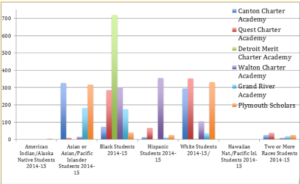
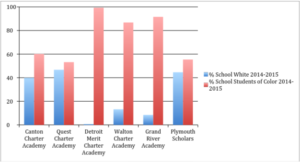
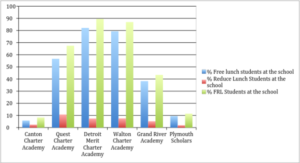
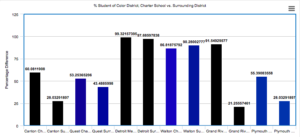
4. Student Achievement
In general, NHA’s claims that they boast high academic achievement in their schools hold water, but there may be underlying causes. According to the 2016 Michigan Student Test of Educational Prep (M-STEP) standardized test scores released by the Michigan Education State Department, each of the six NHA charters we examined outperformed their respective districts in english language arts and mathematics scores in grades 3-8 (MDE, 2016). This might show that the schools that NHA operate are slightly higher achieving than the schools in the surrounding district. At a glance, NHA seem to boast a higher standard of student achievement than do the districts they represent and in some cases Michigan state averages. The graphs below present the 2016 M-STEP scores for the state of Michigan and show ELA and math scores for grades 3-8.
What the graphs don’t and can’t show, however, is that NHA’s claims of high academic performance may be inflated. A Buffalo newspaper reported that there was a trend of students in charter schools transferring to enroll in the public school system again (Meiksins, 2014). It has not been proven, but there is speculation in several reports that students in NHA schools are being asked to leave because their test scores are lowering the school’s test scores (Meiksins, 2014). So, NHA’s claims of higher test score averages could be because they are somewhat self-selecting who they have take the tests.
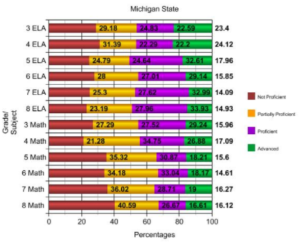

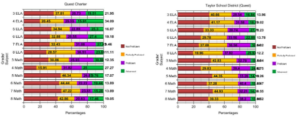
5. School Discipline
NHA uses the language of discipline throughout its website to associate academic success with order and safety. One of NHA’s main core values is acting with discipline to sustain academic prowess (NHA, “Core Values”). NHA promotes the success of its schools through its “moral focus” curriculum and “behave with care” system, which emphasize respect and support in order to create and sustain a safe learning environment (NHA, “Why NHA”). The disciplinary language is both vague and broad and indirectly seems to hold misbehavers accountable for their own lack of learning. This may have a negative impact on english language learners and students with disabilities, because these students may believe that if they can’t understand something, it’s their own fault. Some reviews from teachers on the website Glassdoor emphasized the lack of consistency in the discipline policies and the expectations for the students (Glassdoor, 2017). They also emphasize that there is a very high teacher turnover rate that means the teachers do not learn the stated discipline policy and may not spend as much time with kids who don’t understand the lesson as they should (Glassdoor, 2017). A fired special education teacher from an NHA school even sued NHA, alleging that NHA leans against admitting handicapped students and had deficient services for students with special needs (Golden, 1999).
Among the six charter schools we researched, according to Department of Education Office of Civil Rights data, in the 2013-2014 academic year, four had lower in-school suspension rates than their surrounding districts and two exceeded the in-school suspension rates of their respective districts (OCR, 2014). None of the six charters have any mention of discipline on their individual websites. This data is especially interesting because the Detroit Merit Academy case with its exceptionally high rate of in-school suspensions fails to meet the standards set by NHA and far outweighs its district rates. There is no mention of direct and/or student-oriented initiatives that the charter uses to facilitate and maintain low rates of suspension.
6. Marketing and Media
CMOs and EMOs, in marketing themselves, frequently make use of discourse pertaining to race and diversity, academic quality, and personalized learning experiences for their students (Wilson & Carlsen, 2016). NHA is no exception to these trends, but its marketing places particular emphasis on the language of academic rigor and materially successful outcomes (such as sending students to college after graduation). The front page of NHA’s website features a glitzy video entitled “A Day in the Life of an NHA student,” which includes testimony from a variety of students (NHA, 2016). Both the students featured and the words they say seem distinctly curated: an array of racially diverse children discuss their personal academic achievements, their future goals, abstract values they have learned in school, and the help they receive from their teachers.
Despite the rosy picture painted by NHA’s website, the media attention the organization has received has been largely negative. For example, a 2014 Huffington Post article provocatively entitled, “Why is this Charter School Management Company Still in Business?,” called NHA a “cautionary tale” about the replacement of traditional public schools by charters (Singer, 2014). This article lambasts NHA for its inefficient use of funds and the high-powered political connections that have helped keep it afloat. The article also references the closure of the Rochester Leadership Academy Charter School (a school under the management of the NHA) due to poor academic performance; however, given that the schools we examined exhibited slightly better academic performance than the schools in their surrounding districts, it is hard to know which is the exception and which is the rule.
These factors, particularly the relatively low academic performance of NHA students, suggest that many of the ideals highlighted by NHA’s website are either genuine goals that have not been actualized, or else simply abstract ideas that make NHA schools more marketable.
7. Accountability and Oversight
Because NHA is a private company, they have very little accountability or oversight for their actions. The relationship between the charter schools and NHA has been widely criticized (Singer, 2014; Meiksins, 2014). The NHA, at least as of a 2012 audit, was the sole arbiter of how finances were used within the individual charter schools. Studies have shown that nearly all of the public money given to charter schools under the umbrella of the NHA gets funneled back into the NHA itself, largely for “rent” and “management costs” (Meiksins, 2014).
Furthermore, the NHA has been criticized for its connections to high-power political officials. J. C. Huizenga, the founder and chair of the NHA, was a major campaign donor to the presidential campaigns of both George W. Bush and Mitt Romney. (Singer, 2014; Meiksins, 2014). NHA is also politically aligned with controversial Secretary of Education Betsy Devos. Indeed, much of Devos’s advocacy work in Michigan has come at the direct benefit of NHA and Huizenga (Martinez, 2016). In addition, the NHA has pushed for specific policies that benefit it, at the expense of other charter schools: for example, Huizenga successfully pushed through measures that would ensure that EMO’s as large as NHA could expand without direct permission from local and state education commissions (Barnum, 2017).
While there have been no widely publicized scandals involving the NHA’s leadership of its charter schools, many find its financial and political interests suspect.
8. Funding
Since NHA is a for-profit organization, they need to receive funding to stay afloat while also making a profit. The charter schools that NHA operates receive funding from the state just like public schools do. In return, they agree to be managed by an EMO for purposes of accountability (NHA, “Our Story”).
NHA funds itself partly by charging its schools high rates. For example, the New York Daily News reported that NHA owned property in Brooklyn and charged one of its charter schools there $2.3 million to rent the property, which is $1 million over market rate. This means that the extra $1 million dollars goes to NHA instead of the individual charter schools.
NHA is a private firm and thus doesn’t have to disclose its finances, but its connections to wealthy Republican donors suggest at least some political motivation. Republicans, in general, favor school choice and an expansion of charter schools, and Devos has advocated this view vociferously. Some NHA schools, as well, have gotten in trouble for teaching creationism and other religious doctrines. NHA, therefore, may be trying to serve the Republican agenda in order to keep getting large donations and funding. Since NHA doesn’t have to release any details of its funding, however, it’s not possible to know whether or not this is the case.
9. Staffing
In general, NHA is very positive on its website about hiring teachers and the benefits that come from teaching at an NHA school. The website features many quotes from parents and students, who say that it’s easy for a student to establish a one-on-one relationship with a teacher (NHA, “Why Apply”). But, under the surface, it seems as though the high turnover rate of teachers and the relative inexperience of the teachers may be detrimental to the student’s education.
About half of NHA teachers are recent college graduates, while the other hirees come from other school systems. New hirees are trained in NHA’s educational charter school model. NHA seems to prioritize young teachers who are recent college graduates. The NHA website, however, does not advertise hiring any teachers through TFA.
Digging deeper reveals reviews and blogs posts about NHA and its charter schools, which seems to paint a different picture (Glassdoor, 2017). Reviews of NHA focused on the pressure-filled environment that comes from the corporate overhead that insists on good grades and test scores, the high turnover rate that may be due to poor working conditions, and corporate powers who pull strings while trying to make more money (NHA teacher, 2015). Studies have shown that a high teacher turnover rate can negatively affect student achievement across the whole school, which causes a cycle where some schools are very hard-to-staff. So, the school has to bring in and rely on more inexperienced teachers (Sutcher et. al, 2016). This seems to be the case with NHA, as they have a high turnover rate of teachers and also advertise hiring young teachers.
10. Relationship to the District
Since NHA is a for-profit company, they make cuts and raise costs on their own schools in order to maintain profits to ensure their share-holder satisfaction. The EMOs (not the schools) own the contents of school buildings, including the desks, computers, books and supplies, even while they may have been purchased with taxpayer money (Wood, 2011).
Typically, NHA takes at least 95% of a school’s state aid payments as a fee, pays school bills with the money, and takes whatever remains as a profit (Dixon, 2014). In turn, NHA promises a quality education at the schools, but they have no oversight and the school board can’t have any say in how NHA spends the money. This essentially means that the if there is any way for NHA to save money by not spending it on the school, it will choose to do so. This is because their goal is to make a large profit. The National Education Policy Center noted one particular example of an NHA owned charter in Louisiana, where public transportation is not offered despite 7% of the state funding being given to the school to do so (Crawfish, 2015). Rather, the NHA pocket that money for profit.
The school board lacks any kind of leverage with the NHA, as NHA owns all of the school’s property and could take everything away if the school board decided to fire the NHA. This means that people on the school board have an incentive to not fire NHA, because otherwise, they would be out of a job and the school might close. Several charter schools were told they would be closed if they stopped their contract with NHA (Wood, 2011). When people on the boards of several charter schools under NHA questioned the spending and wanted a new arrangement, they were removed and/or their schools were threatened with closure (Wood, 2011). NHA gets to hand-pick the public school board that they will be accountable to. This conflict of interest ultimately forces NHA-owned schools to comply with NHA’s demands, which therefore indirectly serve NHA’s shareholders and arguably causes harm toward a student’s education.
NHA’s relationship to their surrounding district is shaky. Former and current employees have said that NHA aims to build schools in places that have very low-rated schools so that it doesn’t take much convincing to get people to come to their charter school (Crawfish, 2015). And, as we’ve shown, NHA is concerned with turning a profit, while school districts aren’t, so the school districts seem to be spending more money on their schools and students than NHA does (Crawfish, 2015). School districts are spending more money on things such as technology and transportation, while NHA can get away with not spending the money because they are a for-profit company that is often not beholden to anyone. NHA charter schools may entice parents to send their children to them since they boast of better schools and higher academic performance, but then there has been a trend of parents transferring their children to re-enroll in the public school system again (Meiksins, 2014). This may cause shake-ups in the public school district and affect students and teachers mid-year.
11. Conclusion
Overall, NHA’s mission is to serve a wide variety of students with diverse backgrounds in useful topics that will help them on their way to college. They emphasize their diversity and their teacher-student relationships. The charters schools that NHA manages are, for the most part, more diverse than the public schools in the surrounding districts, and the students in the charter schools have done slightly better in testing than the students in the public schools. These could seemingly be used as arguments to say that NHA is a beneficial education management organization that fulfills many purposes. However, the fact that NHA is a for-profit organization and the deep political ties they have call into question their true motives. While it’s impossible to know where all the money going into NHA is coming from, it’s safe to say that the majority of this money is coming from Republican Party donors and lobbyists, who have an incentive to keep NHA in business. And, they seem to making a lot of money, as they’re continually expanded into more states and are opening more schools. So, while there are purported benefits to the NHA charter schools, NHA is largely a corrupt organization that worries about making money instead of caring for students, teachers, and the individual charter schools.
Works Cited
A Former National Heritage Academies Teacher Speaks About How Happy She Is Working For A Real Public School. (2015, September 21), from http://www.upnorthprogressive.com/2015/09/21/a-former-national-heritage-academies-teacher-speaks-about-how-happy-she-is-working-for-a-real-public-school/
Ash, K. (2013, December 04). For-Profit Charter Management Organizations Expand Reach, Report Says, from http://blogs.edweek.org/edweek/charterschoice/2013/12/for-profit_charter_management_organizations_grow_in_number_report_says.html.
Barnum, M. (2017, January 8). Inside the fight to save Detroit’s schools: Betsy Devos’s campaign for choice over local control. The 74 Million. Retrieved from https://www.the74million.org/article/inside-the-fight-to-save-detroits-schools-betsy-devoss-campaign-for-choice-over-local-control.
Chapman, B., & Smith, G. B. (2014, May 11). Charter schools pay millions in tax dollars to middlemen, from http://www.nydailynews.com/new-york/education/charter-schools-pay-millions-tax-dollars-middlemen-article-1.1787582#ixzz32IkCWlCe.
Crawfish, C. (2015, January 15). Crazy Crawfish’s Blog: National Heritage Academies Makes Money for Themselves, but No Sense for Taxpayers , from http://nepc.colorado.edu/blog/national-heritage-academies.
Dixon, J. (2014, June 22). Michigan’s biggest charter operator charges big rents: 14 schools pay $1M. Detroit Free Press. Retrieved from http://www.freep.com/story/news/local/michigan/2014/06/22/michigans-biggest-charter-operator-charges-big-rents-14-schools-pay/77155250/.
Dixon, J. (2014, December 14). Public money for schools buys private property, from http://www.freep.com/story/news/local/michigan/2014/12/14/charters-national-heritage-academies-tax-dollars-school-contents/20357559/.
Golden, D. (1999, September 16). National Heritage Academies Is Sued By Fired Special-Education Teacher, from https://www.wsj.com/articles/SB937436445303422750.
In-Perspective. Section 8: Charter School Operators, from http://www.in-perspective.org/pages/operators
Martinez, S. (2016, November 23). Trump pick Devos either ‘dangerous’ or ‘exciting.’ M Live. Retrieved from http://www.mlive.com/news/grand-rapids/index.ssf/2016/11/trump_pick_betsy_devos_either.html.
Meiksins, R. (2014, December 12). The problem with for-profits running nonprofit charter schools. Nonprofit Quarterly. Retrieved from https://nonprofitquarterly.org/2014/12/12/the-problem-with-for-profits-running-nonprofit-charter-schools/.
National Heritage Academies (2016, July 26). A day in the life of an NHA student. [Video File]. Retrieved from https://www.nhaschools.com/en/pages/default.aspx.
National Heritage Academies. (n.d.), from https://www.nhaschools.com/en/pages/default.aspx
“School / District Search.” Office of Civil Rights. Civil Rights Data Collection. U.S. Department of Education, n.d. 2014. Web.
Singer, A. (2014, May 27). Why is this charter school management company still in business? Huffington Post. Retreived from http://www.huffingtonpost.com/alan-singer/why-is-this-charter-schoo_b_5397059.html.
“Spring 2016 M-STEP Grades 3-8 and 11.” MDE – Test Results. Michigan Department of Education. 2016. Web.
Strauss, V. (2015, February 28). Separating fact from fiction in 21 claims about charter schools, from https://www.washingtonpost.com/news/answer-sheet/wp/2015/02/28/separating-fact-from-fiction-in-21-claims-about-charter-schools/?utm_term=.88472541dbd9
Sutcher, L., Darling-Hammond, L., & Carver-Thomas, D. (2016). A Coming Crisis in Teaching? Teacher Supply, Demand, and Shortages in the U.S. Learning Policy Institute: Research Brief.
Wang, M. (2016, November 01). When Charter Schools Are Nonprofit in Name Only, from http://billmoyers.com/2014/12/18/charter-schools-nonprofit-name/.
Wilson, T. S., & Carlsen, R. L. (2016). School marketing as a sorting mechanism: A critical discourse analysis of charter school websites. Peabody Journal of Education, 91(1), 24-46.
Wood, M. (2011). National Heritage Academies is a For-Profit Charter Management Company. It has Created a Chain of Private Schools Funded with Public Money. Retrieved from http://www.house.mi.gov/SessionDocs/2011-2012/Testimony/Committee5-11-2-2011-2.pdf
